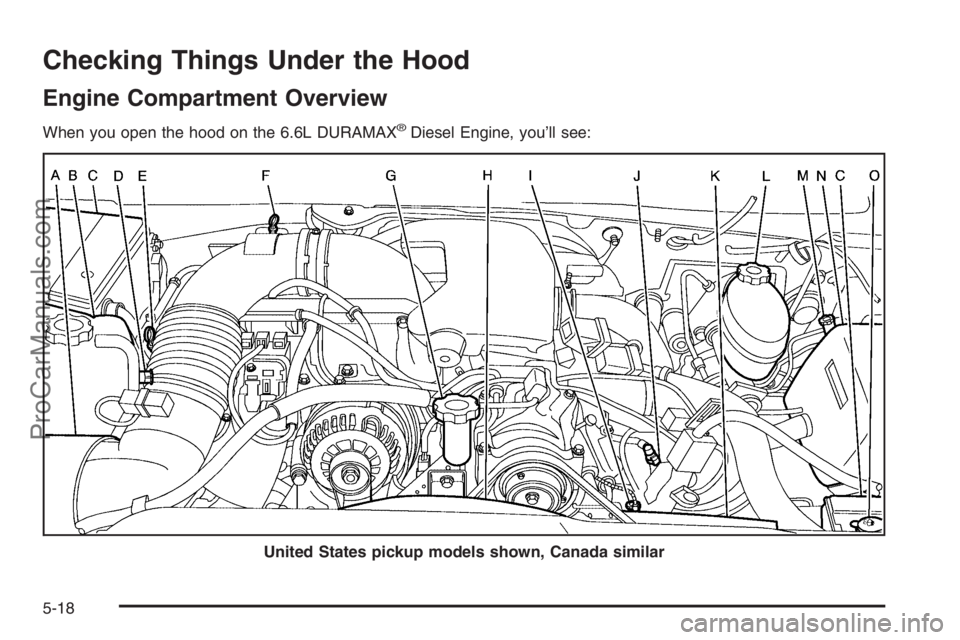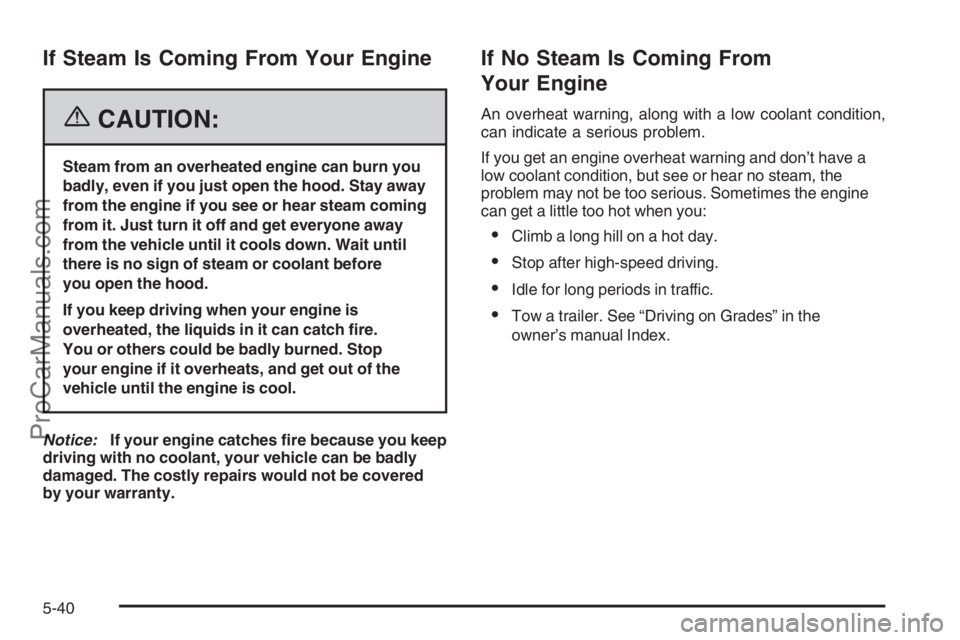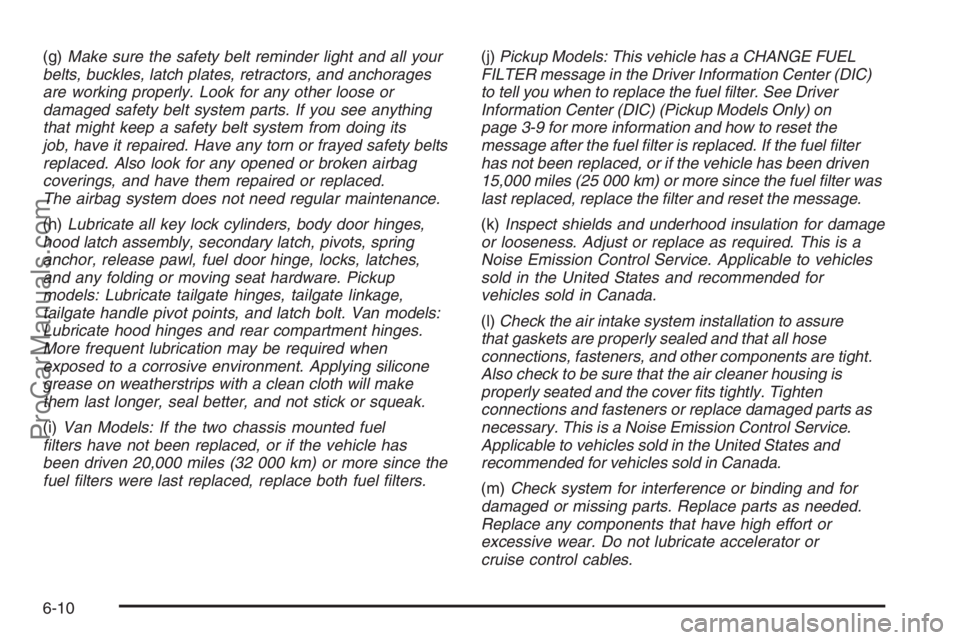open hood CHEVROLET DURAMAX 2006 Owners Manual
[x] Cancel search | Manufacturer: CHEVROLET, Model Year: 2006, Model line: DURAMAX, Model: CHEVROLET DURAMAX 2006Pages: 100, PDF Size: 0.71 MB
Page 10 of 100

Fuel Operated Heater (FOH)
(Van Models Only)
If your vehicle includes a fuel operated heater (FOH),
it will enhance heater performance and will reduce the
amount of time it takes to warm the inside of your vehicle
in cold conditions below 40°F (4.4°C). The fuel operated
heater is installed in the frame rail on the driver’s side of
the vehicle and uses diesel to warm up the engine
coolant, which finally warms up the passenger’s cabin
air. The FOH works automatically, depending on the
fuel level, engine coolant temperature and outside air
temperature. It works only with the engine running.
Engine Coolant Heater
In very cold weather, 0°F (−18°C) or colder, the engine
coolant heater can help. You’ll get easier starting
and better fuel economy during engine warm-up.
Usually, the coolant heater should be plugged in a
minimum of four hours prior to starting your vehicle.
To Use the Engine Coolant Heater
1. Turn off the engine.
2. Open the hood and unwrap the electrical cord.
The cord is located in the engine compartment,
on the passenger’s side of the vehicle, near the
right side engine mount.
3. Plug it into a normal, grounded 110-volt AC outlet.
{CAUTION:
Plugging the cord into an ungrounded outlet
could cause an electrical shock. Also, the
wrong kind of extension cord could overheat
and cause a �re. You could be seriously injured.
Plug the cord into a properly grounded
three-prong 110-volt AC outlet. If the cord
will not reach, use a heavy-duty three-prong
extension cord rated for at least 15 amps.
2-8
ProCarManuals.com
Page 42 of 100

Checking Things Under the Hood
Engine Compartment Overview
When you open the hood on the 6.6L DURAMAX®Diesel Engine, you’ll see:
United States pickup models shown, Canada similar
5-18
ProCarManuals.com
Page 64 of 100

If Steam Is Coming From Your Engine
{CAUTION:
Steam from an overheated engine can burn you
badly, even if you just open the hood. Stay away
from the engine if you see or hear steam coming
from it. Just turn it off and get everyone away
from the vehicle until it cools down. Wait until
there is no sign of steam or coolant before
you open the hood.
If you keep driving when your engine is
overheated, the liquids in it can catch �re.
You or others could be badly burned. Stop
your engine if it overheats, and get out of the
vehicle until the engine is cool.
Notice:If your engine catches �re because you keep
driving with no coolant, your vehicle can be badly
damaged. The costly repairs would not be covered
by your warranty.
If No Steam Is Coming From
Your Engine
An overheat warning, along with a low coolant condition,
can indicate a serious problem.
If you get an engine overheat warning and don’t have a
low coolant condition, but see or hear no steam, the
problem may not be too serious. Sometimes the engine
can get a little too hot when you:
•Climb a long hill on a hot day.
•Stop after high-speed driving.
•Idle for long periods in traffic.
•Tow a trailer. See “Driving on Grades” in the
owner’s manual Index.
5-40
ProCarManuals.com
Page 65 of 100

If you get the overheat warning with no sign of steam,
try this for a minute or so:
1. In heavy traffic, let the engine idle in NEUTRAL (N)
while stopped. If it is safe to do so, pull off the road,
shift to PARK (P) or NEUTRAL (N), and let the
engine idle.
2. Turn on your heater to full hot at the highest fan
speed and open the window as necessary.
If you no longer have the overheat warning, you can
drive. Just to be safe, drive slower for about 10 minutes.
If the warning doesn’t come back on, you can drive
normally.
If the warning continues, pull over, stop, and park your
vehicle right away.
If there’s still no sign of steam and your vehicle is
equipped with an engine driven cooling fan, push down
the accelerator until the engine speed is about twice as
fast as normal idle speed for at least three minutes while
you’re parked. If there is no sign of steam and your
vehicle is equipped with an electric cooling fan, idle the
engine for three minutes while you’re parked. If you still
have the warning,turn off the engine and get everyone
out of the vehicleuntil it cools down.
You may decide not to lift the hood but to get service
help right away.Cooling System
Pickup Models
When you decide it’s safe to lift the hood, here’s what
you’ll see:
A. Coolant Surge Tank Pressure Cap
B. Coolant Surge Tank
C. Engine Fan
If the coolant inside the coolant surge tank is boiling,
don’t do anything else until it cools down. The vehicle
should be parked on a level surface.
5-41
ProCarManuals.com
Page 84 of 100

(g)Make sure the safety belt reminder light and all your
belts, buckles, latch plates, retractors, and anchorages
are working properly. Look for any other loose or
damaged safety belt system parts. If you see anything
that might keep a safety belt system from doing its
job, have it repaired. Have any torn or frayed safety belts
replaced. Also look for any opened or broken airbag
coverings, and have them repaired or replaced.
The airbag system does not need regular maintenance.
(h)Lubricate all key lock cylinders, body door hinges,
hood latch assembly, secondary latch, pivots, spring
anchor, release pawl, fuel door hinge, locks, latches,
and any folding or moving seat hardware. Pickup
models: Lubricate tailgate hinges, tailgate linkage,
tailgate handle pivot points, and latch bolt. Van models:
Lubricate hood hinges and rear compartment hinges.
More frequent lubrication may be required when
exposed to a corrosive environment. Applying silicone
grease on weatherstrips with a clean cloth will make
them last longer, seal better, and not stick or squeak.
(i)Van Models: If the two chassis mounted fuel
�lters have not been replaced, or if the vehicle has
been driven 20,000 miles (32 000 km) or more since the
fuel �lters were last replaced, replace both fuel �lters.(j)Pickup Models: This vehicle has a CHANGE FUEL
FILTER message in the Driver Information Center (DIC)
to tell you when to replace the fuel �lter. See Driver
Information Center (DIC) (Pickup Models Only) on
page 3-9 for more information and how to reset the
message after the fuel �lter is replaced. If the fuel �lter
has not been replaced, or if the vehicle has been driven
15,000 miles (25 000 km) or more since the fuel �lter was
last replaced, replace the �lter and reset the message.
(k)Inspect shields and underhood insulation for damage
or looseness. Adjust or replace as required. This is a
Noise Emission Control Service. Applicable to vehicles
sold in the United States and recommended for
vehicles sold in Canada.
(l)Check the air intake system installation to assure
that gaskets are properly sealed and that all hose
connections, fasteners, and other components are tight.
Also check to be sure that the air cleaner housing is
properly seated and the cover �ts tightly. Tighten
connections and fasteners or replace damaged parts as
necessary. This is a Noise Emission Control Service.
Applicable to vehicles sold in the United States and
recommended for vehicles sold in Canada.
(m)Check system for interference or binding and for
damaged or missing parts. Replace parts as needed.
Replace any components that have high effort or
excessive wear. Do not lubricate accelerator or
cruise control cables.
6-10
ProCarManuals.com